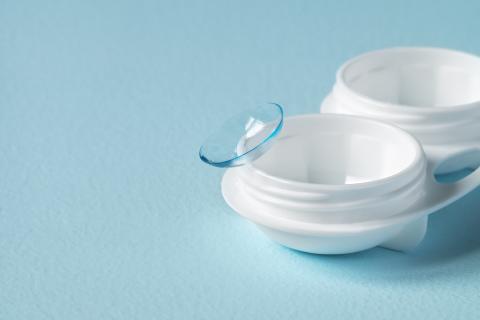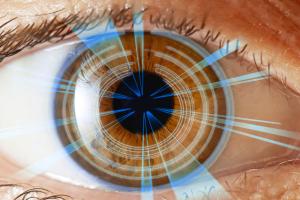by Dr. Melody Huang

Many patients don’t realize that there are various contact lens materials available. The material can make a big difference in their vision, comfort, and eye health. As a member of an eye care team, it’s essential to know the advantages and disadvantages of different lens materials to help patients understand why a particular contact lens is best for them!
History of contact lens materials
Some people give Leonardo da Vinci credit for the concept of the first contact lens. However, recent analysis shows that this may not be true1. It was Sir John Herschel, a British astronomer, who came up with the first contact lens design in 1827. This design led to the creation of the first glass contact lens in 1887, which covered the entire eye2!
In 1948, the first plastic contact lenses were introduced2, made of a material called polymethyl methacrylate (PMMA). These were hard contacts similar to the modern rigid gas permeable (RGP) contact lenses available today, except that they did not allow for the transmission of oxygen. Few people still use PMMA lenses, as most doctors have switched their rigid lens wearers over to RGP lenses since they are more breathable.
The first commercially available soft contact lens was introduced in 19712. These were made out of hydrogel, a hydrophilic (water-loving) polymer. Hydrogel plastic feels soft and flexible after absorbing water, but hard when it is dried out. In 1981, the concept of soft extended wear contacts was introduced. These contacts are made for overnight wear, as opposed to removing them every night before sleep. Next came the hybrid lens in 19853, which are contacts that have a rigid lens center with a surrounding soft lens “skirt.”
Contact lenses became even more convenient to use when the first disposable soft contact lenses were launched in 1987, and the first daily disposable contacts were released in 19952. Another significant milestone in contact lens history is the introduction of silicone hydrogel (SiHy) lens material, which arrived in the United States in 20022. The highly breathable4 SiHy material has changed the way many eye care professionals prescribe contact lenses. A variety of silicone hydrogel products followed, including custom-manufactured SiHy lenses and the first SiHy daily disposable contact lenses, which were introduced in 20102.
Soft contact lens materials
Soft contacts are primarily made from hydrogel or silicone hydrogel material. The features of these materials can affect eye health and the patient’s overall experience using the contacts5.
Some important features include4:
- Comfort (affected by wettability, lens stiffness (or modulus), and water content, among other things)
- Wear time (related to comfort issues and oxygen permeability)
- Oxygen permeability (how much oxygen passes through the contact lens to reach the eye)
- Handling (SiHy lenses may be easier to insert and remove)
- Vision (affected by dryness and deposits)
Hydrogel lenses
Hydrogel material is extremely flexible due to its water content. This flexibility makes hydrogel contact lenses feel soft and comfortable on the wearer compared to rigid lenses.
The main hydrogel material used for soft contacts is poly(2-hydroxyethyl methacrylate), usually called poly-HEMA. The oxygen permeability of hydrogel lenses depends on the water content. The higher the water content, the more oxygen that can pass through the lens.
Silicone hydrogel lenses
This newer generation of lenses allows more oxygen to reach the eye than standard hydrogel lenses (approximately 5 times more oxygen6). Unlike hydrogel lenses, the oxygen permeability of SiHy lenses depends on the amount of silicone used, not the water content5.
Silicone has a gel-like consistency that is flexible and often used in other medical devices, such as medical implants7. Silicone is also used in modern RGP lenses to increase their oxygen permeability.
The earliest silicone hydrogel lenses were treated with a coating to improve their wettability5. Wettability affects the comfort and dryness of contact lenses5. Some companies use a plasma treatment, while others use specific wetting agents8. These treatments increase the hydrophilic properties of the lens. In many cases, CooperVision builds the wettability of its silicone hydrogel lenses into the lens chemistry itself so that surface treatments or internal wetting agents are not needed9. Since this is the latest technology to achieve wettability in silicone hydrogel materials these are called third generation materials10.
What materials are eye care practitioners prescribing?
In 2019, U.S.-based practitioners fitted patients with the following percentages of contact lens materials11:

- 65% Silicone hydrogel
- 24% Hydrogel
- 9% Rigid gas permeable
- 2% Hybrid
- 0% Polymethyl methacrylate
Internationally, 72% of patients who were fitted with soft contact lenses are using silicone hydrogel contacts. This includes data from multiple countries over the past 15 years12.
We can see from this data that SiHy lenses are the preferred material of practitioners who fit contact lenses11!
Hydrogel versus silicone hydrogel lenses
There are benefits and drawbacks to both types of soft lenses. However, as we saw in the section above, most eye care practitioners are prescribing SiHy lenses for specific reasons.
One of the biggest benefits of silicone hydrogel lenses is that they minimize the risk of corneal hypoxia13. This condition occurs when the cornea (the clear surface on the front of the eye) does not receive enough oxygen14. Hypoxia causes redness, blurry vision, abnormal blood vessel growth on the cornea, and corneal swelling14. Hypoxia may also increase the risk for eye infections, such as corneal ulcers14.
Advantages of hydrogel
- Highly flexible material5
- Good initial comfort5
- Thinner lenses15
- Affordable16
- Available in a variety of modalities (daily disposable, 2-week disposable, monthly replacement)16
- Available in different designs (sphere, toric, multifocal)16
Disadvantages of hydrogel
- Low oxygen permeability5
- Potentially higher risk for eye infections and other hypoxia-related issues14
- Not ideal for overnight wear5
Advantages of silicone hydrogel
- High oxygen permeability5
- Easier to handle (particularly for new contact lens wearers)5
- Better durability5
- Extended wear and overnight wear options available (longer wear time)13
- Available in a variety of modalities16
- Available in different designs16
Disadvantages of silicone hydrogel
- Early silicone hydrogel lenses sometimes had wettability challenges although newer SiHy materials have similar or better wettability than hydrogel lenses
- Early silicone hydrogel lenses used stiffer materials, however, newer SiHy materials have improved flexibility similar to that of hydrogels9
- Potentially higher risk for giant papillary conjunctivitis (GPC), an allergic reaction in the inner part of the eyelid with early SiHy materials, however, this is not a concern with newer, low modulus monthly and 1 day SiHy lenses.18
- Slightly higher price, although newer lenses like clariti® 1 day are close to price parity with 1 day hydrogel lenses.
Silicone hydrogel contacts on the market
Silicone hydrogel lenses are available in all types of wearing modalities and designs. Some common brands include:
Monthly
- Biofinity® *^
- PureVision®
- PureVision® 2
- Ultra® *^
- Air Optix®*^Aqua with Hydraglyde®
- Air Optix® Night & Day®
- Acuvue® Vita® *
2-week
- Avaira Vitality™ *
- Acuvue® Oasys® with Hydraclear® Plus *^
- Acuvue® Oasys® with Transitions™
Daily
*Indicates availability in toric lenses, ^Indicates availability in multifocal lenses (also toric multifocal in some brands)
Overnight and extended wear contact lenses
Contact lenses that are approved for wear while sleeping are usually made of silicone hydrogel5.
When you’re awake, your eyes receive oxygen through your tear film, which is distributed across the eye each time you blink. While your eyes are closed, the palpebral conjunctiva (the tissue lining the inner portion of your eyelid) delivers oxygen and nutrients to your cornea19.
Sleeping with contact lenses reduces the amount of oxygen your eyes receive. This increases your risk for corneal hypoxia and infections. People who sleep in contacts are also more prone to dry eyes, inflammation, and allergies since they are wearing contacts for longer periods and cleaning them less frequently14. Deposits and allergens are more likely to build up on the contacts.
Ideally, patients should remove their contacts before bed. However, this isn’t practical in some cases where patients need to be ready at any moment, such as with military or first responder personnel.
If sleeping without contact lenses isn’t possible, overnight or extended wear contacts are the next best thing. Because these lenses have high oxygen permeability, they are safer to use while sleeping versus standard hydrogel lenses6.
Extended wear lenses are typically worn for up to 6 nights (7 days). After giving the eyes a break without contact lenses for one night, the extended wear schedule may be resumed the next night. The Eye Care Practitioner should determine the appropriate wearing time and provide specific instructions to the patient regarding lens care, insertion and removal.
Extended wear SiHy lenses include:
- Biofinity®
- Air Optix®Aqua with Hydraglyde®
- Air Optix® Night & Day®
- PureVision®
- PureVision® 2
- Ultra®
- Acuvue® Oasys® with Hydraclear® Plus
Materials make a difference
Choosing the right contact lens material can improve comfort and vision. This is particularly true for patients with sensitive eyes, allergies, dry eyes, or other conditions that can affect contact lens wear.
Many surveys show that the top reason for contact lens dropout (when patients stop wearing contacts) is discomfort20. It is important for contact lens patients to know that there are options out there. Some lens materials may work better for an individual than others.
You can really wow your patients by educating them about contact lenses. Let them know that they don’t have to stick to the same contacts they’ve worn for the past 10 years just because they’re “okay.”
So the next time a patient asks, “Is there really any difference between all these contacts?”, you’ll have the answer for them!
Did you know? CooperVision® has the world’s largest portfolio of silicone hydrogel lenses. Learn more about each of our brand families at the links below.
CLICK HERE FOR PART 2: CL DESIGNS
____________________________________________________________________________
Sources
Caroline PJ, Norman CW. History of Contact Lenses: The Da Vinci Code Cracked. Contact Lens Spectrum. https://www.clspectrum.com/issues/2020/february-2020/history-of-contact-lenses.
Heiting G. When Were Contact Lenses Invented? All About Vision. https://www.allaboutvision.com/contacts/faq/when-invented.htm.
Sicks LA. Hybrid Lens Basics. American Optometric Association. https://www.aoa.org/Documents/optometric-staff/Articles/Hybrid%20Lens%20Basics%20Article.pdf.
Musgrave CSA, Fang F. Contact Lens Materials: A Materials Science Perspective. Materials (Basel). 2019;12(2):261.
Vinita Allee Henry, Steve Diamanti & Julie Ott DeKinder (2020), ”Soft Material Selection (Hydrogel & Silicone Hydrogel)” in Clinical Manual of Contact Lenses, 5th Ed., Eds. Ed Bennett and Vinita Henry, China: Wolters Kluwer, pp. 288-310.
Efron N, Morgan PB, Cameron ID, et al. Oxygen permeability and water content of silicone hydrogel contact lens materials. Optom Vis Sci. 2007;84(4):328-337.
Heiting G. Silicone hydrogel contact lenses: a complete guide. All About Vision. https://www.allaboutvision.com/contacts/silicone-hydrogel.htm.
Schorner S. Some Facts About SiHy Lenses. Review of Optometry. https://www.reviewofoptometry.com/article/some-facts-about-sihy-lenses.
Eye Contact Lens. 2013 Jan;39(1):100-108.
Tighe B. A Decade of Silicone Hydrogels. Eye & Contact Lens, Volume 39, Number 1, January 2013
Nichols JJ, Starcher L. Contact Lenses 2019. Contact Lens Spectrum. https://www.clspectrum.com/issues/2020/january-2020/contact-lenses-2019.
Morgan PB, Woods CA, Tranoudis IG, et al. International Contact Lens Prescribing in 2019. Contact Lens Spectrum. https://www.clspectrum.com/issues/2020/january-2020/international-contact-lens-prescribing-in-2019.
Stapleton F, Stretton S, Papas E, et al. Silicone Hydrogel Contact Lenses and the Ocular Surface. Ocul Surf. 2006;4(1):24-43.
Liesegang, TJ. Physiologic Changes of the Cornea with Contact Lens Wear. CLAO J. 2002;28(1):12-27.
For Ocular Health and Comfort, This Type of Daily Disposable Contact is for You. CooperVision. https://coopervision.com/blog/ocular-health-and-comfort-type-daily-disposable-contact-you.
ODspecs. ODspecs.com. http://www.odspecs.com/.
Eiden SB. Does One Contact Lens Solution Fit All? Review of Cornea and Contact Lenses. https://www.reviewofcontactlenses.com/article/does-one-contact-lens-solution-fit-all.
Eye & Contact Lens. 2014 Jan; 40 (1): 51-57.
Holden BA, Sweeney DF. The oxygen tension and temperature of the superior palpebral conjunctiva. Acta Ophthalmol (Copenh). 1985;63(1):100-103.
Pucker AD, Tichenor AA. A Review of Contact Lens Dropout. Clin Optom (Auckl). 2020;12:85-94.






